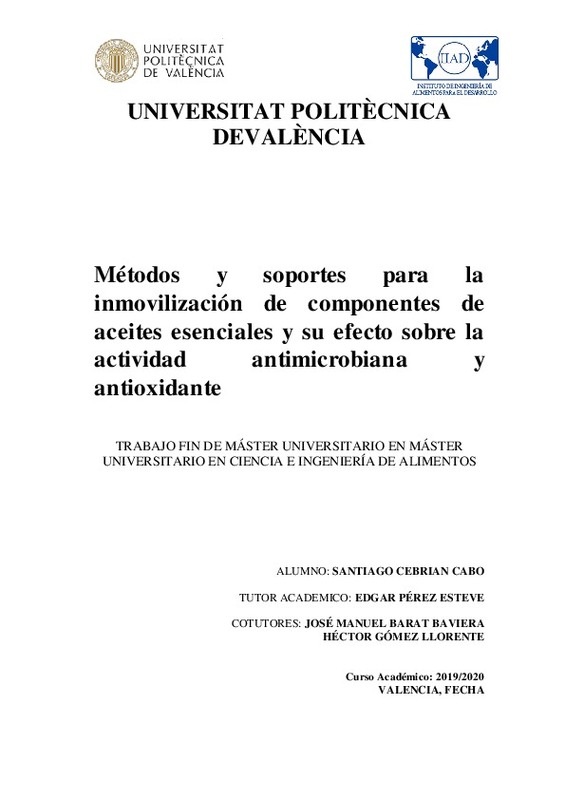|
Resumen:
|
[ES] Los compuestos de aceites esenciales (eugenol, carvacrol, vainillina y timol) están siendo muy estudiados por sus excelentes propiedades antimicrobianas y antioxidantes para ser utilizados en tecnología de alimentos. ...[+]
[ES] Los compuestos de aceites esenciales (eugenol, carvacrol, vainillina y timol) están siendo muy estudiados por sus excelentes propiedades antimicrobianas y antioxidantes para ser utilizados en tecnología de alimentos. Sin embargo, debido a sus propiedades fisicoquímicas (solubilidad, volatilidad, fuerte olor, sabor, aroma, baja estabilidad, etc), la adición directa de estos compuestos a un alimento conlleva una serie de limitaciones. Una solución a estos problemas pasaría por la inmovilización de estos compuestos bioactivos sobre nano y microestructuras. En este contexto, el presente trabajo tiene por objetivo estudiar los principales métodos y soportes para la inmovilización de componentes de aceites esenciales, para su posterior uso en la industria alimentaria. Los resultados demuestran que existen diversos tipos de soportes que pueden ser empleados para la inmovilización, siendo los más comunes los basados en polímeros, óxidos de metales y materiales cerámicos. Éstos difieren entre sí en tamaño, morfología, composición y capacidad para la funcionalización. De ellos destaca la sílice mesoporosa MCM-41 como el material más empleado, debido a su gran versatilidad y reactividad química. Respecto al método de anclado, la unión mediante enlace covalente ha demostrado ser la más eficaz. Esta revisión también demuestra que la inmovilización de aceites esenciales en soportes nano y microestructurados permite obtener compuestos biológicos compatibles con las condiciones de proceso (pH, temperatura y humedad) y ser reutilizables, adquiriendo un mayor rendimiento.
[-]
[EN] Essential oil compounds (eugenol, carvacrol, vanillin, and thymol) are being widely studied for their excellent antimicrobial and antioxidant properties for use in food technology. However, due to their physicochemical ...[+]
[EN] Essential oil compounds (eugenol, carvacrol, vanillin, and thymol) are being widely studied for their excellent antimicrobial and antioxidant properties for use in food technology. However, due to their physicochemical properties (solubility, volatility, strong smell, taste, aroma, low stability, etc.), the direct addition of these compounds to a food entails a series of limitations. A solution to these problems would be the immobilization of these bioactive compounds on nano and microstructures. In this context, the present work aims to study the main methods and supports for the immobilization of essential oil components, for their subsequent use in the food industry. The results show that there are various types of supports that can be used for immobilization, the most common being those based on polymers, metal oxides and ceramic materials. These differ from each other in size, morphology, composition and capacity for functionalization. Among them, the mesoporous silica MCM-41 stands out as the most used material, due to its great versatility and chemical reactivity. Regarding the anchoring method, the union by covalent bond has proven to be the most efficient. This review also demonstrates that the immobilization of essential oils in nano and microstructured supports allows obtaining biological compounds compatible with the process conditions (pH, temperature and humidity) and being reusable, acquiring a higher performance..
[-]
|







